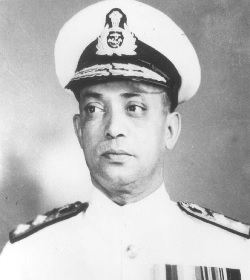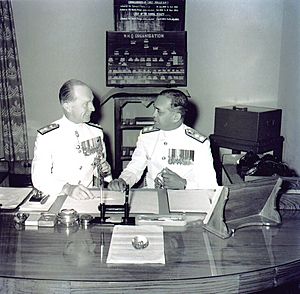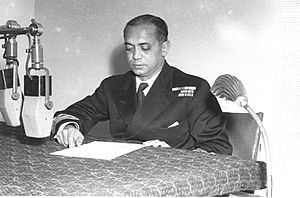Ram Dass Katari facts for kids
Quick facts for kids
Admiral
Ram Dass Katari
|
|
|---|---|
 |
|
| 5th Indian Ambassador to Burma | |
| In office 1 June 1964 – 8 February 1969 |
|
| President | S. Radhakrishnan Zakir Husain |
| Preceded by | R. S. Mani |
| Succeeded by | Baleshwar Prasad |
| 8th Chairman of the Chiefs of Staff Committee | |
| In office 7 May 1961 – 4 June 1962 |
|
| President | Rajendra Prasad S. Radhakrishnan |
| Prime Minister | Jawaharlal Nehru Gulzarilal Nanda (acting) |
| Preceded by | K. S. Thimayya |
| Succeeded by | A. M. Engineer |
| 3rd Chief of the Naval Staff (India) | |
| In office 22 April 1958 – 4 June 1962 |
|
| President | Rajendra Prasad S. Radhakrishnan |
| Prime Minister | Jawaharlal Nehru Gulzarilal Nanda (acting) |
| Preceded by | S. H. Carlill |
| Succeeded by | B. S. Soman |
| Personal details | |
| Born | 8 October 1911 Chingleput, Madras Presidency, British Raj (now in Tamil Nadu, India) |
| Died | 21 January 1983 (aged 71) Secunderabad, Andhra Pradesh, India |
| Relations | Admiral Laxminarayan Ramdas (Son-in-law) |
| Military service | |
| Allegiance | |
| Branch/service | |
| Years of service | 1927–1962 |
| Rank | |
| Commands | Indian Fleet INS Rajput (D141) HMIS Kistna (U46) HMIS Cauvery (U10) |
| Battles/wars | World War II Liberation of Goa |
| Later work(s) |
|
Admiral Ram Dass Katari (born October 8, 1911 – died January 21, 1983) was a brave officer in the Indian Navy. He became the 3rd Chief of the Naval Staff (CNS), leading the Indian Navy from April 22, 1958, to June 4, 1962. He was the very first Indian officer to hold this important position, taking over from a British officer.
Admiral Katari was part of the first group of cadets at the Indian Mercantile Marine Training Ship Dufferin. He was a top student and later worked on the Hooghly River Survey. During World War II, he joined the Royal Indian Naval Reserve. He served on several ships and became an expert in fighting submarines.
After India became independent, he commanded the ship HMIS Kistna (U46). He also helped lead naval forces during the Indian integration of Junagadh. He held many important roles, including commanding the Indian Fleet. His time as Navy Chief saw the launch of India's first aircraft carrier, INS Vikrant. He also led naval operations during the Liberation of Goa. After retiring from the Navy, he served as India's ambassador to Burma.
Contents
Early Life and Education
Ram Dass Katari was born in Chingleput, a town in Madras Presidency, on October 8, 1911. His father was an engineer working for the government. Ram Dass spent most of his childhood and teenage years in Hyderabad. He went to Mahbub College High School and then Nizam College in Hyderabad for his studies.
After finishing college, Katari joined the Indian Mercantile Marine Dufferin in 1927. This was the first group of Indian cadets to train there. He scored the highest on the entrance exam. He even became the first graduate of TS Dufferin to serve on its Governing Board later on. After his training, he worked for the Calcutta Port Commissioners. His job was to survey the Hooghly river, which meant mapping its changing riverbed. He worked on special survey ships and eventually led these surveys himself.
Serving in World War II
In 1939, when World War II began, Katari joined the Royal Indian Navy Reserve (RINR). He became a temporary officer, a Sub Lieutenant, on September 23, 1939. He served on the ship HMIS Sandoway. Later, he was sent to HMIS Dalhousie, a naval gunnery school. He also worked at HMIS Bahadur, a training center for young sailors.
Katari served in both the Atlantic and Indian Oceans. He became a specialist in anti-submarine warfare, which means finding and fighting enemy submarines. He also taught at the Anti-Submarine Warfare School. By the end of the war, he was a lieutenant-commander. He commanded HMIS Cauvery (U10) and led operations to clear mines around the Andaman & Nicobar Islands.
After India's Independence
When India gained independence, Katari was a Commander. He commanded HMIS Kistna (U46). He led naval operations to protect the coast during the Indian integration of Junagadh. This involved several Indian Navy ships working together.
In 1948, India bought a new warship, INS Delhi (C74), from the United Kingdom. This ship became the flagship of the Indian Navy. Katari served as the executive officer of the INS Delhi. In December 1948, he was promoted to acting Captain. He then became the Chief of Personnel at the Naval Headquarters.
In 1951, Captain Katari took command of the 11th Destroyer Flotilla. He was also the Commanding Officer of its lead ship, INS Rajput (D141). In 1953, he was chosen to attend the Imperial Defence College in the United Kingdom. He was the first Indian Naval officer to get this opportunity. After his training, he returned to India in 1954. He was appointed the Deputy Commander-in-Chief.
Leading the Indian Fleet
In 1955, the Indian government announced that Katari would become the Flag Officer (Flotillas) Indian Fleet. This meant he would be the first Indian officer to command the entire Indian Fleet. He was promoted to acting Rear Admiral in March 1956. Before taking command, he visited naval bases and shipyards in the UK and Europe. He even visited HMS Nigeria (60), which would later become INS Mysore (C60) for the Indian Navy.
On October 2, 1956, he officially became a Rear Admiral and took command of the Indian Fleet. His flag was raised on the INS Delhi. He chose October 2 for the ceremony to honor Gandhi Jayanti. In 1957, the new flagship, INS Mysore, was commissioned, and his flag was moved to that ship.
In February 1958, Katari was chosen to be the first Indian Chief of the Naval Staff (CNS). On April 22, 1958, he was promoted to Vice Admiral and took charge of the Indian Navy.
As CNS, he helped create India's plan for managing its maritime security. During his time, the Indian Navy grew stronger. They acquired new ships and improved their training and operations. India's first aircraft carrier, INS Vikrant, was commissioned while he was CNS. He also led the naval operations during the liberation of Goa from Portuguese rule in December 1961.
He retired as CNS on June 4, 1962. At that time, Vice Admiral was the highest rank in the Indian Navy.
After retiring from the Navy, Admiral Katari continued to serve his country. From December 1962 to May 1964, he was the Chairman of the Andhra Pradesh State Road Transport Corporation (APSRTC). In 1964, he became India's Ambassador to Burma (now Myanmar), serving there for over five years.
He was also known for creating the daily crossword puzzles for The Hindu newspaper until he passed away. He wrote a book called A Sailor Remembers, which shares his memories of the early years of the Indian Navy.
In 1968, the rank of CNS was upgraded to a full admiral. Later, on October 21, 1980, Admiral Katari and his successor, Bhaskar Sadashiv Soman, were given the honorary rank of full Admiral by President Neelam Sanjiva Reddy.
Family Life
Admiral Katari was married to Dhanam Katari. They had two children, a daughter named Lalita and a son named Ravi. His daughter Lalita married his flag lieutenant, Laxminarayan Ramdas. Interestingly, Ramdas later also became the Chief of Naval Staff, just like his father-in-law.
Legacy and Memorials
Admiral Katari passed away in Secunderabad on January 21, 1983, at the age of 71. Many places and awards are named in his honor:
- The Katari Memorial Hall in Sainikpuri, near Secunderabad, was dedicated to him on his 100th birth anniversary in 2011.
- The Admiral R. D. Katari Marg in Sainikpuri, where the College of Defence Management is located, is named after him.
- Katari Bagh in Willingdon Island in Kochi also bears his name.
- The cadet's dining hall at the Indian Naval Academy is named after Katari.
- The Admiral R. D. Katari Trophy is awarded to the best Sub Lieutenant during their initial training.
- The Navy Foundation organizes the ADM R. D. KATARI MEMORIAL LECTURE every year to remember his contributions.
See also
- Field Marshal K. M. Cariappa
- Air Marshal Subroto Mukerjee



